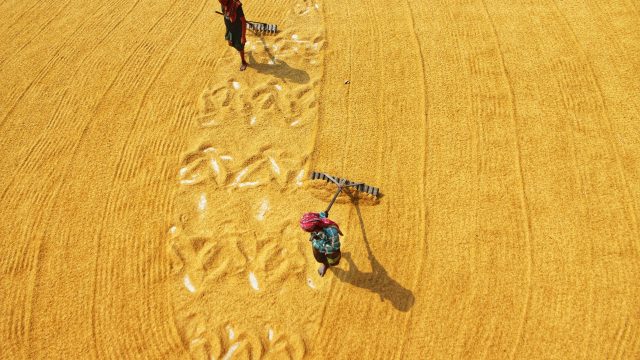Shaking the money pot to protect nature

The perceived abundance of natural capital, often treated as endless and free, is leading to overuse and under-investment - with poor people the most affected. Yet we constantly hear that money doesn’t grow on trees and there’s not enough to invest in the environment. How can we shake the piggy bank to give something back to nature?
According to Markus Lehmann, from the Convention on Biological Diversity, implementing the twenty Aichi biodiversity targets by 2020 – such as addressing underlying causes of biodiversity loss and safeguarding ecosystems, species and genetic diversity – will deliver substantial benefits to people and economies, but requires massive resource mobilisation. Initial estimates place this cost in the region of US$130 billion to US$440 billion per year globally, and will require significant mobilisation of international and domestic public finance.
Already under high fiscal pressure, this is a challenging request for Ministers of Finance, who face the burden of having to provide for short-term (and more politically visual) demands like schools, roads, dams and water pipes. But it does not always have to be about “either-or” and penny pinching, but being a bit cannier on managing that purse.
Poverty, biodiversity and natural capital
The 22nd meeting of the Poverty Environment Partnership (PEP22) held in New York from 19-22 June, brought together over 60 participants from 41 organisations and 12 countries to talk about natural capital investments in relation to environmental and social commitments, such as the Aichi Targets, the Paris Climate Agreement, and the Sustainable Development Goals (SDG). I joined a selected panel with Eike Meyer (GIZ), Katia Karousakis (OECD) and Robert Repetto (IISD), as well as policy makers from Uganda, South Africa and Nepal to discuss how fiscal reform can help governments step up to the challenge.
Rethinking biodiversity finance strategies
The good news is that much can already be achieved by mainstreaming biodiversity into existing expenditures for development, environmental protection and natural resource management. The Biodiversity Finance Strategy (BIOFIN), for example, encourages a strategic approach to biodiversity finance to look at how well governments spend our money. This means understanding linkages, prioritising needs, and realigning existing expenditures to meet financing gaps. The focus, according to BIOFIN, is not only about new and more resources but on changing the narrative and the dialogue around nature.
The urgency for the change in narrative and action is critical. A new study from the OECD shows the imbalance of investments in nature: for every positive investment action (e.g. payments for ecosystem services) there are ten negative ones (e.g. fuel subsidies that contribute to overfishing and over-extraction of water).
“ Subsidies benefit the rich more than the poor, and reforming subsidies actually mobilises financial resources that can be used for more targeted support to low-income households.”
Cheap but not cheerful…
Governments constantly use subsidies to make things cheap: to buy or to produce. While they distort market prices, subsidies are powerful levers to influence groups. Agriculture is a haven for subsidies. The UK spends £3 billion per year on subsidies, many for wealthy landowners in rather inefficient ways. In February this year, the government of Nepal announced a 50 per cent subsidy to farmers using modern farming technologies. Bhutan gives free, or very low cost, electricity to rural households to reduce the use of firewood. Subsidies to improve fleet capacity, or reduce the cost of fuel, are commonly used in fisheries in the EU, China and USA.
But all this giving away has a cost, and someone is paying the bill. Fossil fuel subsidies in Nepal discourage investments in renewable electricity, and reduce the cost of water extraction for irrigation, leading to waste, reduced water tables and increased water salinity. India’s generous subsidies (e.g. to rice, railways, kerosene, electricity and fertilizers) cost the nation about 4.24 percent of 2015 GDP. Subsidies to the fishing industry amount to US$35 billion annually worldwide, and are causing such havoc in fish stocks that the 2017 Ocean Conference has urgently called for an end to perverse subsidies. Fertilizer subsidies for food production, like cereal crops, has been linked to soil degradation and water pollution in China, with direct impacts on people’s health. The overall scale of water subsidies through public utilities is very high (US$456 billion per year), limiting cost-recovery options and disproportionally benefiting upper-income groups.
Changing narratives through pricing and subsidy reform
Relinquishing or reducing such subsidies, introducing water pricing or taxing waste are often rejected on the grounds of their impacts on the poor. Yet, in reality, the opposite is often true: subsidies benefit the rich more than the poor and reforming subsidies actually mobilises financial resources that can be used for more targeted support to low-income households. Eike Meyer (GIZ) illustrated experiences from Indonesia and Vietnam, where sound ex-ante impact assessments of energy pricing reforms helped identify affected business sectors and income groups, and formed the basis for the design of targeted exemptions and compensation measures.
Better pricing of natural capital can help send signals to encourage a more sustainable use of resources, reduce waste, mobilise revenues and balance out budgets to enable actions towards the Aichi Targets and the SDGs. At the PEP22, participants agreed that for such pricing and subsidy reform to gain traction three actions are needed: 1) a combined effort to gather evidence and identify winners and losers ahead of reform; 2) a more explicit approach to understand the linkages between environment and people and to disentangle real from perceived impacts; and 3) a serious effort to improve communication, declutter economic jargon and make the case for reform an intuitively viable option.
This is not an easy task. The risk to revert policies may be high for governments, but the risks of inaction are piling up and can no longer be ignored.
Dr Ina Porras, Senior Economist, IIED
Dr Porras is a Costa Rican/British economist, with 22 years of experience in environmental and resource economics in Latin America, Africa and Asia. Her current work focuses on valuation and governance of ecosystem services, natural capital accounting, and financing strategies for sustainable natural capital management -including environmental fiscal reform. She also teaches at the University of Edinburgh.


